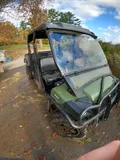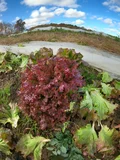TL;DR
I washed leeks then harvested carrots and lettuce. It was a very overcast and windy day, but the rain held off. I also submitted more homework for the Farm Business Planning course I’m taking.
A Nicely Washed Leek
I’ve seen all stages in these leeks’ lifecycle, from watering them in the nursery, planting them in the frigid muck, collecting and then spreading salt marsh hay over them, to now harvesting and washing them over the past few weeks. They are worth it all. In a soup, lightly shaved into a salad (or better when their whole roots are in tact, sprinkling those in), braised and oven baked in ramekins, mandolin sliced and dehydrated, or even pickled, every part of the plant is versatile and delicious.
But I don’t trust the average consumer to look at a dirty leek and still enjoy it, even though there’s always some dirt somewhere in/on them no matter how carefully they are washed. You may have asked yourself, “why is there dirt down in between the layers of a leek?” Let me explain…during harvest, dirt goes absolutely everywhere. If you don’t shake it out (really bang it out on your leg or ground), you’re hauling twice the weight than otherwise back to the wash station.
But after snipping off the roots and excess wispy tops then peeling back any damaged or dry layers, what’s left is mostly clean. Both ends still need to be thoroughly shaken out in water, but the bottoms horizontally so and the tops can be vertically dunked a few times to get most of the grit out. Trust me, it’s worth my time to clean your leeks properly for you.
A Nicely Washed Bunch of Carrots
Of the few times, each a dangerous and retributive experience, where someone in Anne of Grene Gables commented that her hair looked like carrots, I can understand how insulting this must have been. However…however…watching this as early as six years old (two years after it came out), I always associated carrots with the prettiest and most wholesome things that could exist.
Fresh carrots are the soil’s gift to studious farmers and gardeners. In previous posts, I’ve extolled the virtues of farm fresh carrots versus the “baby carrots” often fed to small children as if they’re healthy. I’d also like to add that, despite my confusion about why the deer will eat our lettuces but not our yummy choy sum, they also agree that even carrot greens are nummy. I’ve used diced up carrot fronds in roasted oven carrots to add an extra carrot-y umph in the past, but really it’s the underground root that’s worth the spotlight.
Yes I love carrots enough to wash them thoroughly )but not too much to leave some dirt on them) for customers, but some of the work should be theirs so that they feel the odd and non-processed shape with their own hands at home. And yes, I did watch my copy of Anne of Green Gables (stored from our DVD set on my Jellyfin homelab server) this weekend with the family.
A Head Full of Lettuce
There are two types of lettuce harvesting methods we use on this farm: head and loose leaf. For loose leaf greens, we chop at about 2-4 inches from the soil so that it can ‘come again’ (e.g. regrow through and beyond that mark). For head lettuce, we chop right at the base of the plant. Most heads have some imperfections in the lowest leaves that are closest to the soil, usually insect damage or excess moisture issues.
Some home gardeners pluck their leaves from lettuces like we do with kale and swiss chard (more of a ‘snap’ really), but for at-scale farming this is too slow and labor intensive to be at all profitable. I can’t think of any crop that we ‘pluck’, except for ‘snap’ ones. We don’t grow peas or beans which are kind of in between a ‘pluck’ and a ‘snap’. Yeah, lettuce is a chop, either whole head or as loose leaf.
A few weeks ago when we really felt the fall season come in, there was so much take-home lettuce, I had bags and bags of it. I processed it all at home and gave it out to neighbors and friends, that’s how much we had. Now I take less home per week, but I do take a non-zero amount because it’s fantastic. Just ask our deer.
If you don’t ‘like lettuce’ or similarly ‘cabbage’, try it with a little smear of peanut butter. If you’re allergic to peanuts, try cottage cheese or pate or hummus or avocado. If you’re allergic to these things or cabbage itself, avoid most snack foods because they’re full of all of the above, not to mention sugar and salt.
AI Summary from Field Notes
When I was young someone called me out for convoluting something in a conversations. I looked up what that meant and realized that they didn’t fully understand what it meant either. In today’s field notes, the LLM summary process convoluted a comment about how I “took a break to go fill the gas tank” and later how we “filled up the EV van with produce”, such that it resulted in:
“filled the van with gas”
Had this been a fancy AI-generated, fully automated note to my manager, I would have gotten a call about how a fully electric van doesn’t need gas. My point here is that, unless we understand how to flag errors and reinforce positive patterns, there’s no real ‘learning’ to LLMs in practice. Albeit LLMs are only the latest AI craze, but if something doesn’t continuously learn, then can you really call it intelligence? If learning isn’t built in to every use of the technology, then IMO it’s not intelligent, artificial or biological.
Summary
Final Summary:
Main Themes:
- Farm Operations: Daily tasks such as harvesting, cleaning, equipment maintenance, and animal care.
- Logistics: Managing bins, CSA pickups, and resource allocation (e.g., scraps for pigs).
- Team Coordination: Interactions with staff (e.g., Jamie), visitors, and equipment users.
- Sustainability: Efficient use of resources (e.g., scraps for pigs, bin management).
Activities the Intern Performed:
- Cleaned the wash area and prepared for harvest.
- Washed and binned fridge leaks from the previous day.
- Took a personal call and filled the van with gas.
- Cleaned the gator (four-seat vehicle) for a farm tour.
- Loaded the van with blue buckets and harvested carrots and lettuces.
- Harvested lettuces after lunch and sorted/cleaned produce in the garage.
- Watered pigs and chickens, using scraps (leeks, tomatoes, mustard greens) for fattening/treats.
- Assisted with minor tasks (e.g., bin management, animal care).
New Things Encountered:
- Visitor Interaction: Engaged with potential general store managers during a farm tour.
- Gator Maintenance: Ensured the gator was clean and functional for tours, highlighting equipment upkeep.
- Scrap Management: Used specific scraps (e.g., mustard greens) for pigs, a novel process.
- Bin Management: Limited bin availability on Monday/Tuesday, requiring coordination with CSA pickups.
Questions for Future Research/Suggested Actions:
- Bin Management: Optimize bin availability by scheduling pickups or requesting additional bins.
- Scrap Efficiency: Track which scraps are most beneficial for pigs and how to improve their use.
- Gator Maintenance: Establish a protocol for keeping the gator clean for tours.
- Scrap for Pigs: Determine if certain scraps (e.g., mustard greens) are more effective for fattening.
- Task Coordination: Streamline harvesting and bin-sorting to reduce delays.
Suggested Actions:
- Request additional bins or coordinate with CSA for more frequent pickups.
- Document scrap usage for pigs to identify optimal types and quantities.
- Create a routine for gator maintenance to ensure it’s always clean for tours.
- Improve bin organization (e.g., labeling, tracking) to reduce inefficiencies.
- Communicate with Jamie to coordinate tasks (e.g., harvest times, bin sorting).
Part 1
Main Themes:
- Farm Operations: Harvesting, cleaning, equipment maintenance, and animal care.
- Logistics: Managing bins, CSA pickups, and resource allocation.
- Team Coordination: Interactions with Jamie and other staff, including visitors.
- Sustainability: Using scraps for pigs, efficient use of resources.
Activities the Intern Did:
- Cleaned the wash area and prepared it for harvest.
- Washed and binned leaks from the fridge (left over from the previous day).
- Took a personal call and filled the van with gas.
- Cleaned the gator (four-seat vehicle) to a spotless condition for a farm tour.
- Loaded the van with blue buckets and met Jamie to harvest carrots and bunch them.
- Harvested lettuces (2.5–3 bins) after lunch.
- Cleaned and sorted carrots and lettuces in the garage.
- Watered pigs and chickens, collecting scraps (leeks, tomatoes, bad mustard greens).
- Assisted with minor tasks (e.g., bin management, animal care).
New Things Not Yet Encountered:
- Visitors: Interaction with potential general managers of the general store during a farm tour.
- Gator Maintenance: Ensuring the gator was clean and functional for a tour, emphasizing the importance of equipment upkeep.
- Scrap Management: Using specific types of scraps (e.g., mustard greens) for pigs, which may be a novel process for the intern.
- Bin Management: Limited availability of bins on Monday/Tuesday, requiring coordination with CSA pickups.
Questions for Future Research/Suggested Actions:
- Bin Management: How to optimize bin availability (e.g., schedule pickups, request additional bins).
- Scrap Efficiency: What types of scraps are most beneficial for pigs, and how to track their use.
- Gator Cleanliness: What is the protocol for maintaining the gator for visitor tours?
- Scraps for Pigs: Are certain scraps (e.g., mustard greens) more effective for fattening, or is it a matter of availability?
- Team Coordination: How to streamline tasks (e.g., harvesting, bin sorting) to reduce delays.
Suggested Actions:
- Request additional bins or coordinate with CSA for more frequent pickups.
- Document scrap usage for pigs to identify optimal types and quantities.
- Establish a routine for gator maintenance to ensure it is always clean for visitors.
- Improve bin organization (e.g., labeling, tracking) to reduce inefficiencies.
- Communicate with Jamie to coordinate tasks (e.g., harvest times, bin sorting).
[end of post]
Enjoy Reading This Article?
Here are some more articles you might like to read next:







